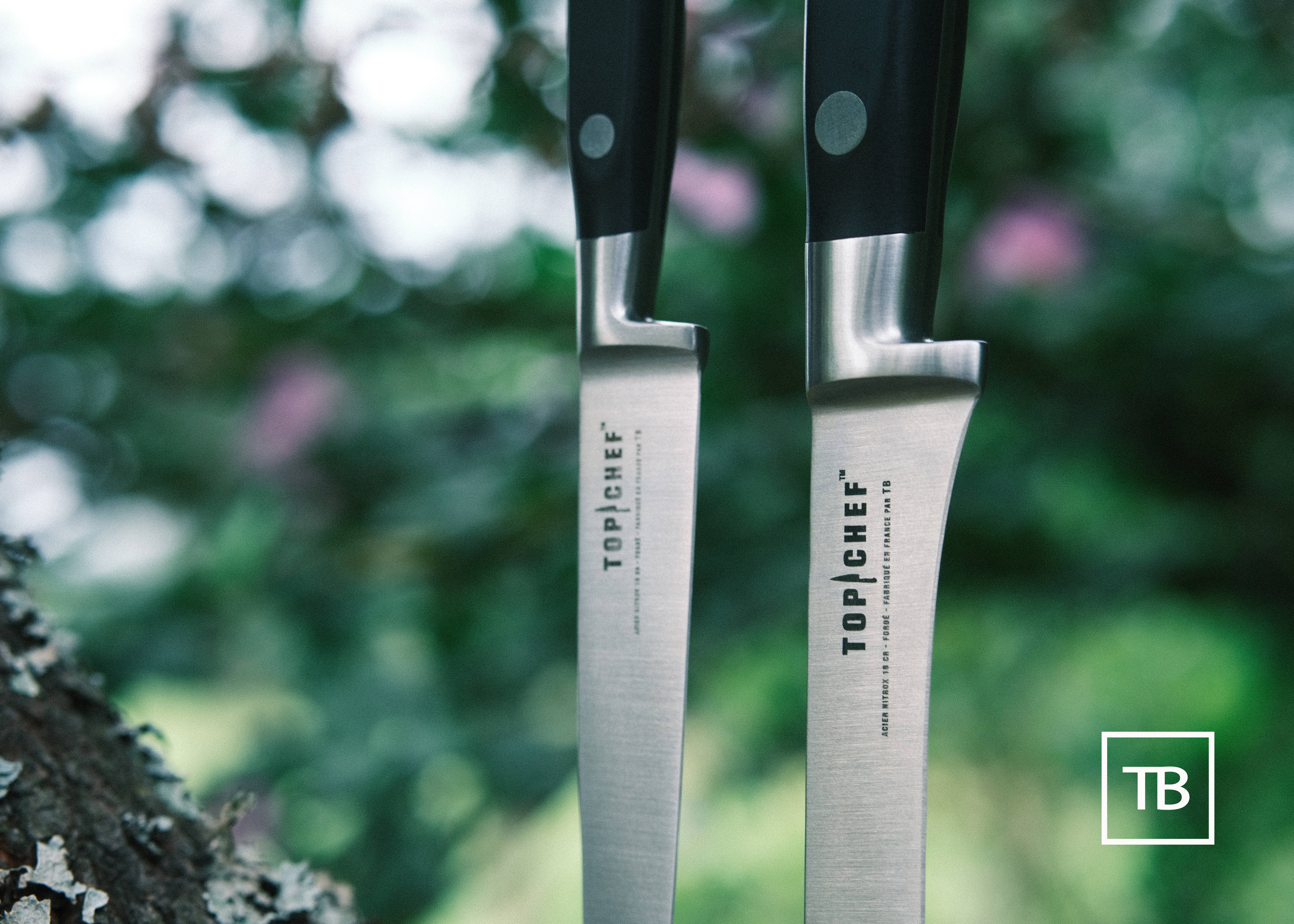In the kitchen, each type of knife has a specific role, and choosing the right tool can greatly improve the efficiency and safety of your preparations. The kitchen knife is a versatile tool, but there are different models suited to specific tasks. In this guide, we present the most common types of knives, their specificities and how to use them for impeccable results.
1. The Chef’s Knife: The Kitchen Must-Have
The chef's knife is the ultimate kitchen knife. It is designed for a multitude of tasks ranging from cutting vegetables to preparing meats. With its wide blade, generally between 20 cm and 30 cm, it allows for rocking movements to cut efficiently.
Uses:
- Chop, mince, cut, and slice vegetables, fruits, and herbs.
- Slice meats and fish.
- Prepare complex dishes with precise cuts.
Features :
- Long, wide blade, ideal for swinging cuts.
- Balanced weight for comfortable grip.
- Versatile tool for all kinds of culinary preparations.
2. The Santoku Knife: Japanese Excellence
The Santoku knife is a Japanese knife that has gained popularity due to its specific shape and great versatility. It is shorter than the chef's knife, with a blade of about 18 cm, and its flat geometry allows for clean slices.
Uses:
- Ideal for finely slicing vegetables, meats and fish.
- Practical for fine and precise cuts, especially in Asian kitchens.
Features :
- Straight and short blade.
- Designed for clean cuts with high precision.
- Suitable for smaller hands or users who prefer a more manageable knife.
3. The Paring Knife: For Precision Tasks
The paring knife is the kitchen knife par excellence for small cutting jobs. Its blade, which generally measures between 8 and 10 cm, makes it extremely handy and perfect for fine cuts.
Uses:
- Peel, cut, and slice vegetables and fruits into small portions.
- Make fine cuts such as garnishes or decorations.
Features :
- Small blade, ideal for detailed tasks.
- Excellent grip for maximum control.
4. The Bread Knife: The Solution for a Cut Without Crushing
The bread knife is distinguished by its serrated blade, which allows you to cut thick-crusted breads without crushing the crumb. It is an essential tool for those who like to prepare or enjoy homemade breads.
Uses:
- Cut breads of all kinds.
- Cutting up hard-skinned produce, such as tomatoes.
Features :
- Long, serrated blade.
- Ideal for cutting hard crusts without altering the interior texture of the bread.
5. The Boning Knife: To Separate Meat from Bone
The boning knife has a thin, flexible blade, ideal for separating meat from bones precisely. It is particularly useful for working with meat, such as chicken, ribs or pieces of game.
Uses:
- Bone meats, poultry and fish.
- Working on bones and joints with precision.
Features :
- Thin, flexible blade for clean, precise cutting.
- Fine tip for delicate cutting work.
6. The Slicing Knife: For Perfect Slices
The slicing knife is designed specifically for cutting roast meats, cold cuts and hams into thin, even slices. Its long, narrow blade allows you to cut without tearing the meat.
Uses:
- Cut thin slices of cooked meats, cold cuts, and ham.
- Slice sensitive products without crushing them.
Features :
- Long, narrow blade, perfect for thin slices.
- Clean cutting without altering the texture of food.
7. The Ham Knife: For Precise Slices
The ham knife is a thinner and more flexible model than the slicing knife. It is specially designed to cut ultra-thin slices of ham, whether raw or cooked.
Uses:
- Slice the ham into thin strips.
- Delicate cuts of charcuterie.
Features :
- Long, flexible blade for delicate slices.
- Flexibility that allows cutting without too much pressure.
8. The All-Purpose Knife: The Everyday Ally
The all-purpose knife is a multifunctional kitchen knife that can replace several other types of knives. It usually has a blade of around 15 cm, which makes it suitable for many tasks in the kitchen.
Uses:
- Cutting fruits, vegetables, meat, fish, and cheese.
- Ideal for everyday cutting tasks.
Features :
- Mid-size blade, offering versatility.
- An excellent compromise for amateur cooks.
9. The Sole Fillet Knife: The Fish Specialty
The sole fillet knife has a very thin and flexible blade, ideal for working with fish. It allows you to remove fish fillets with precision, following the contours of the bones without damaging the flesh.
Uses:
- Fillet the fish, especially thin fish like sole.
- Cut the edges cleanly and precisely.
Features :
- Flexible and thin blade, ideal for delicate cuts.
- Allows you to easily follow the bones of the fish.
Conclusion: Choosing the Right Kitchen Knife
Each kitchen knife has been designed for a specific use, and it is essential to choose the one that suits your needs. A good knife will not only allow you to work more efficiently, but also ensure clean and safe cuts.
At TB 1648 , we offer a wide range of kitchen knives made in the Thiers basin, so that you can work like a true professional. Whether you are an experienced chef or a cooking enthusiast, investing in a good knife is essential to obtain perfect results with each preparation.



















